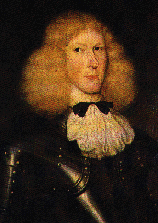 | Campbells on the Net Clan Campbell Discussion Area Clan Campbell Contacts Orr Family Name Focus of One Name Studies Researcher Charity tries to rescue Campbell Portraits from Christie's Auction Block |
 | Campbells on the Net Clan Campbell Discussion Area Clan Campbell Contacts Orr Family Name Focus of One Name Studies Researcher Charity tries to rescue Campbell Portraits from Christie's Auction Block |

 Throughout the fifteenth century the Campbells gave steady support to the Crown in an area where royal influence was under severe pressure, first from the rival Crown of Norway and then from the descendants of Somerled, former Lord of the Isles, with the eventual emergence of the Crown's most powerful rival in the MacDonald Lordship of the Isles. The Lordship of the Isls was broken by the Crown by the end of the fifteenth century, leaving the Campbells the main power in the area. Thereafter they continued to act as the chief instrument of central authority in the region. This long struggle for supremacy, and with it, the headship of the Gael, may be said to be the real cause for the ancient enmity between the Campbells and the MacDonalds.
Throughout the fifteenth century the Campbells gave steady support to the Crown in an area where royal influence was under severe pressure, first from the rival Crown of Norway and then from the descendants of Somerled, former Lord of the Isles, with the eventual emergence of the Crown's most powerful rival in the MacDonald Lordship of the Isles. The Lordship of the Isls was broken by the Crown by the end of the fifteenth century, leaving the Campbells the main power in the area. Thereafter they continued to act as the chief instrument of central authority in the region. This long struggle for supremacy, and with it, the headship of the Gael, may be said to be the real cause for the ancient enmity between the Campbells and the MacDonalds.
Campbell support for central government brought rewards. In 1607 Archibald, seventh Earl of Argyll, was granted former MacDonald lands in Kintyre, while in 1615 Campbell of Cawdor was allowed to purchase Islay and most of Jura which had previously belonged to the Macleans of Duart.
Sir John Campbell (1635-1716), 11th Laird of Glenorchy, was created Earl of Breadalbane in 1681. Described as being "cunning as a fox, wise as a serpent, and supple as an eel... [who] knew neither honour nor religion but where they are mixed with interest", he was involved in the scheming which resulted in the Massacre of Glencoe, but no evidence of his guilt could be produced.
 His line was founded by the colourful crusader "Black" Colin Campbell (d. 1498), who received Glenorchy in 1432 from his father, Sir Duncan Campbell, who had ejected the MacGregors from the lands. The commander who actually carried out the infamous Massacre of the MacIan MacDonald's of Glencoe was a Campbell Chieftain of Glenlyon.
The founder of the Cawdor branch, another Sir John Campbell (d. 1546). An orphan who had inherited her father's title of Thane of Cawdor, she was kidnapped in 1499 by Campbell’s father, Archibald (d. 1513), 2nd Earl of Argyll, and married to his son in 1510. The Campbells of Loudoun are descended from Sir Duncan Campbell, second of the first MacCailean Mór, who married a Crauford of Loudoun. The Earldom of Loudoun, created for John Campbell (1598-1663), politician, has since the eighteenth century descended through the female line.
His line was founded by the colourful crusader "Black" Colin Campbell (d. 1498), who received Glenorchy in 1432 from his father, Sir Duncan Campbell, who had ejected the MacGregors from the lands. The commander who actually carried out the infamous Massacre of the MacIan MacDonald's of Glencoe was a Campbell Chieftain of Glenlyon.
The founder of the Cawdor branch, another Sir John Campbell (d. 1546). An orphan who had inherited her father's title of Thane of Cawdor, she was kidnapped in 1499 by Campbell’s father, Archibald (d. 1513), 2nd Earl of Argyll, and married to his son in 1510. The Campbells of Loudoun are descended from Sir Duncan Campbell, second of the first MacCailean Mór, who married a Crauford of Loudoun. The Earldom of Loudoun, created for John Campbell (1598-1663), politician, has since the eighteenth century descended through the female line.
Arguably the most famous Campbell of them all, Sir Colin Campbell (1792-1863), commander of the Highland Brigade at Balaclava, Commander-in-Chief during the Indian Mutiny, the hero of Lucknow and Cawnpore, was not strictly a Campbell at all, being born Colin MacLiver, son of a Glasgow carpenter. His mother was a Campbell, though, and when her brother, Colonel John Campbell, took the fifteen-year-old boy to be interviewed for the Army by the Duke of York, the Duke wrote his name down as Campbell. And Campbell it remained.
The Clan Campbell is now organized world-wide in several associations and societies connected to the Clan Campbell Federation. The current Chief is the twelfth Duke of Argyll and twenty-sixth Chief. Inveraray Castle is still his family home.






